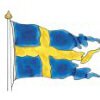A (Very) Compressed History of Sweden
Writer’s note: Presenting 1,300 years of Swedish history in no more than a dozen pages is not really feasible. My goal is that it should be fun to read and interesting for anyone who is interested in Sweden and wants to know Sweden’s background. A history professor may have chosen to describe different events and different persons in a different way, even if the most important parts would be the same.
 Part 1: The Viking Age
Part 1: The Viking Age
Did you know that Swedish Vikings actually were the founders of Russia, as described in manuscripts from the 12th century, found in Ukraine monestaries? The Vikings traveled up along the rivers that lead to the Baltic Sea, pulled their ships on land and continued along the great Russian rivers, down to the Caspian Sea and Black Sea. Read more!
Part 2: Sweden In The Middle Ages
Before the 11th century, Sweden didn’t exist, nor did any European country. A map would have shown hundreds of small states, from Sicily in the south to Svea Rike in the north. Today’s Sweden was a number of small kingdoms. Three families competed for the crown of a united kingdom; the winners were descendants of a man who neutered horses with his teeth. Read more!
Part 3: The Rise And Fall Of A Superpower
 At it’s largest, in the 17th and 18th centuries, Sweden controlled Finland, Estonia, Latvia, Lithuania, Pomerania, Schlesvig-Holstein, parts of Norway, and parts of Russia. Swedish armies ventured into Germany, Austria, Russia, Ukraine and Turkey, and established colonies in the Americas and Africa. Three kings and one queen reigned during this period, but the last king reigned the country via mail for 14 years and lost it all because of his love for adventures. Read more!
At it’s largest, in the 17th and 18th centuries, Sweden controlled Finland, Estonia, Latvia, Lithuania, Pomerania, Schlesvig-Holstein, parts of Norway, and parts of Russia. Swedish armies ventured into Germany, Austria, Russia, Ukraine and Turkey, and established colonies in the Americas and Africa. Three kings and one queen reigned during this period, but the last king reigned the country via mail for 14 years and lost it all because of his love for adventures. Read more!
Part 4: Fine Arts, Factories, Vodka And Emigration
 History tells us that in the last half of the 18th century, a pastry killed one king, another king was assassinated, a third was dethroned and started a playboy life roving around Europe, spreading his seed. The 19th century begun with a war that led to the loss of Finland, and continued with another war in which Norway was conquered. A new royal dynasty ascended to the Swedish throne, but royal power was coming to an end, and famine and drinking were tormenting the country. Read more!
History tells us that in the last half of the 18th century, a pastry killed one king, another king was assassinated, a third was dethroned and started a playboy life roving around Europe, spreading his seed. The 19th century begun with a war that led to the loss of Finland, and continued with another war in which Norway was conquered. A new royal dynasty ascended to the Swedish throne, but royal power was coming to an end, and famine and drinking were tormenting the country. Read more!
Part 5: Between Wars: Founding “Folkhemmet”
 The 20th century brought about unrest and world war. Even if Sweden managed to stay out of the wars, the first decades were hard in a country being among the poorest in Europe. But a new era had begun, building a modern welfare country. The now powerless king spent his time hunting moose and playing tennis, but he actually had the guts to challenge Adolf Hitler in his own office to berate him. Read more.
The 20th century brought about unrest and world war. Even if Sweden managed to stay out of the wars, the first decades were hard in a country being among the poorest in Europe. But a new era had begun, building a modern welfare country. The now powerless king spent his time hunting moose and playing tennis, but he actually had the guts to challenge Adolf Hitler in his own office to berate him. Read more.
Part 6: And Now What?
 At the beginning of the 20th century, Sweden numbered among the poorest countries in Europe. Only 70 years later, Sweden qualified as one of the wealthiest. Part of the explanation is the fact that Sweden stayed out of the great wars, but that’s not all. Most governments have been following “the third way”, i.e. a capitalist system that’s both supported and curbed by the state. In spite of high wages, generous welfare, and high taxes, Swedish enterprises have managed to be competitive and Swedes have enjoyed a living standard among the world’s highest. But the future looks uncertain… Read more.
At the beginning of the 20th century, Sweden numbered among the poorest countries in Europe. Only 70 years later, Sweden qualified as one of the wealthiest. Part of the explanation is the fact that Sweden stayed out of the great wars, but that’s not all. Most governments have been following “the third way”, i.e. a capitalist system that’s both supported and curbed by the state. In spite of high wages, generous welfare, and high taxes, Swedish enterprises have managed to be competitive and Swedes have enjoyed a living standard among the world’s highest. But the future looks uncertain… Read more.

